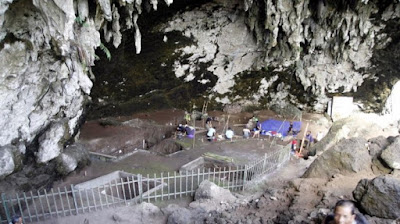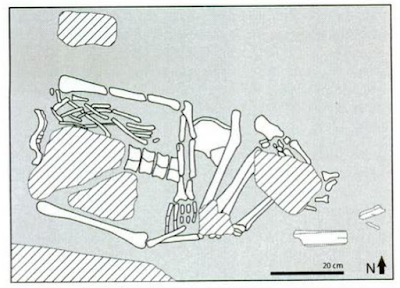 |
| Braholo Cave Excavations. Image Source: Detik.Travel |
Braholo Cave (Goa Braholo) Excavation in Indonesia
Braholo Cave is a very large cave with a 40 meter opening roughly 15 meters above the foot of the hill. Throughout the years, over 16 zones have been opened for excavation. The excavation sites range between 4 and 7 meters and date from 3,000 to 33,000 BC.Thomas said that other ancient human fossils had also been discovered several years ago, which were estimated to have lived around 7,000 to 9,000 BC. These humans had been practiced some rather intriguing burial rituals, including intentional bone breaking or cutting. They were usually positioned on their back with a slight angle to the right. The position would be maintained by placing two large stones over the torso.
 |
| Diagram of Braholo Cave ancient Burials. Image Source: Indonesian Institute of Sciences |
“However,” Thomas continues, “The fossils found today are not of prehistoric humans, but from a slightly more recent time.”
New Findings in Braholo Cave
The recent findings were buried at a depth of one to four meters. Thomas revealed the findings of the research team as mainly deer, monkey, pigs, dogs, mice, and buffalo. This helps to give some insight into the fauna that were present in Gunung Kidul during those days. |
| Braholo Cave Excavation. Image: Liputan6 |
“Ancient man in Braholo Cave would often consume these animals,” he explains. "They hunted animals and brought them to their dwelling here in Braholo Cave. These animals were used to feed a community of ancient humans that dwelt in these caves.”
The discovery of these fossils is being conducted by a team of researchers from the National Archaeological Center in partnership with a team from the University of Gadjah Mada. Excavation has been ongoing since 9 October 2017.
Location and Access to Braholo Cave
The cave is accessible by public transport such as buses, taxis, and ojek (motorbike taxi), or via your personal transportation. The cave is roughly 40km from Yogyakarta’s Adisucipto International Airport.
There is no admission charge to enter the cave. Guests are simply requested to keep the environment clean and free from vandalism or damage.


0 comments:
Post a Comment